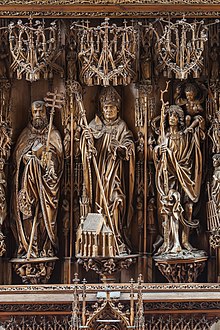Kefermarkt altarpiece

The Kefermarkt Altarpiece (German: Kefermarkter Flügelaltar) is an altarpiece made between 1490 and 1497 by an unidentified artist sometimes referred to as the Master of the Kefermarkt Altarpiece. The altarpiece is considered one of the main works of late Gothic art in the German-speaking part of Europe. The altar is today a popular tourist attraction in Kefermarkt close to Freistadt in Austria. It is considered one of the three great altarpieces from the late 15th century of the German sprachraum together with the Pacher Altarpiece in St. Wolfgang im Salzkammergut (Austria) and the Veit Stoss altarpiece in Kraków (Poland). It is the main altarpiece of Church of St. Wolfgang in Kefermarkt.
History
Commission
The lord of a nearby castle, Christoph von Zellking, commissioned the building of a new church for Kefermarkt between 1470 and 1476. In his last will and testament from 1490 he provided the money to pay for an altarpiece dedicated to Saint Wolfgang. The altarpiece had certainly by that time already been commissioned, and work on it may already have been started. In the following year, Christoph von Zellking died. A receipt from 1497 (later lost) documented the final payment for the altarpiece, indicating that the retable may have been installed in the church that year.[1]
To accommodate the new altarpiece, the choir of the church had to be rebuilt in 1491. The presentation of the altarpiece in the church has been changed throughout the centuries, and it is today in the position in which it was placed in 1684. The predella of the altarpiece has been lost, as well as the backside of the altarpiece.
Restoration
The altarpiece was originally painted with distemper, but during a renovation in the 19th century all the paint was removed. Restoration works were carried out between 1852 and 1855 under the leadership of Adalbert Stifter, after it was discovered that common furniture beetles were damaging the wooden piece of art. During the renovation some parts of the altarpiece were replaced or altered by carpenters Johann Rint and Josef Rint. The renovation has been criticised, not least the removal of the paint. A second renovation was carried out in 1896, this time inspired by the explorer Andreas Reischek, who was born in Kefermarkt. Other restorative works have been made in 1904 and 1916 to 1918. In 1929, a new attempt to get rid of furniture beetles damaging the altarpiece was made using Zyklon B. In 1959 an attempt was made to get rid of the beetles for the last time, as the altarpiece then was cleaned and impregnated. The window panes of the choir were furthermore treated to make the light less damaging to the altarpiece.[2]
Description

The 13.5 metres (44 ft) high and 6.3 metres (21 ft) wide altarpiece, one of the largest Gothic wooden pieces of art in Europe, was made of linden wood. In the centre section, the shrine of the altarpiece, saints Peter, Wolfgang and Christopher are depicted in a scale larger than life. They are supported by richly carved corbels and crowned by baldachins. On the two wings are depictions of the life of Mary. In the elaborately carved superstructure, the saints Mary, Catherine and Barbara are depicted while the upper part displays representations of Agnes of Rome flanked by busts of prophets and crowned by a sculpture of Saint Helena. The carefully made sculptures are completely individual and do not even display the same kind of clothing or attributes.
Adalbert Stifter provides a description of the altarpiece in his novel Der Nachsommer (where he calls in the "Kerberger Altarpiece").[3]
Gallery
-
Left wing (below): Adoration of the Magi
-
Right wing (below): Death of the Virgin
-
Superstructure
Literature
- Adalbert Stifter: Über den geschnitzten Hochaltar in der Kirche zu Kefermarkt. Erstdruck in: Jahrbuch des Oberösterreichischen Musealvereines 13, (1853) Digitalisat, 1MB pdf
- Lothar Schultes: Der Meister des Kefermarkter Altars. Die Ergebnisse des Linzer Symposions. (Studien zur Kulturgeschichte von Oberösterreich, Folge 1), Linz 1993
- Otto Wutzel: Das Schicksal des Altars von Kefermarkt. In: Rudolf Lehr: Landes-Chronik Oberösterreich, Wien: Verlag Christian Brandstätter 2004, S. 96ff.
- Ulrike Krone-Balcke: Der Kefermarkter Altar –- sein Meister und seine Werkstatt, Deutscher Kunstverlag, München 1999 (Zugl. Univ., Diss., München 1995)
External links
References
- ^ Kahsnitz, Rainer (2006). Carved Splendor: late gothic altarpieces in Southern Germany, Austria, and South Tirol. Getty Publications. pp. 164–180. ISBN 978-0-89236-853-2.
- ^ Otto Wutzel: Das Schicksal des Altars von Kefermarkt in der Landes-Chronik Oberösterreich 2004, S. 96ff. (Geschichte und Restaurierung)
- ^ Der Nachsommer - Kapitel 33 online



